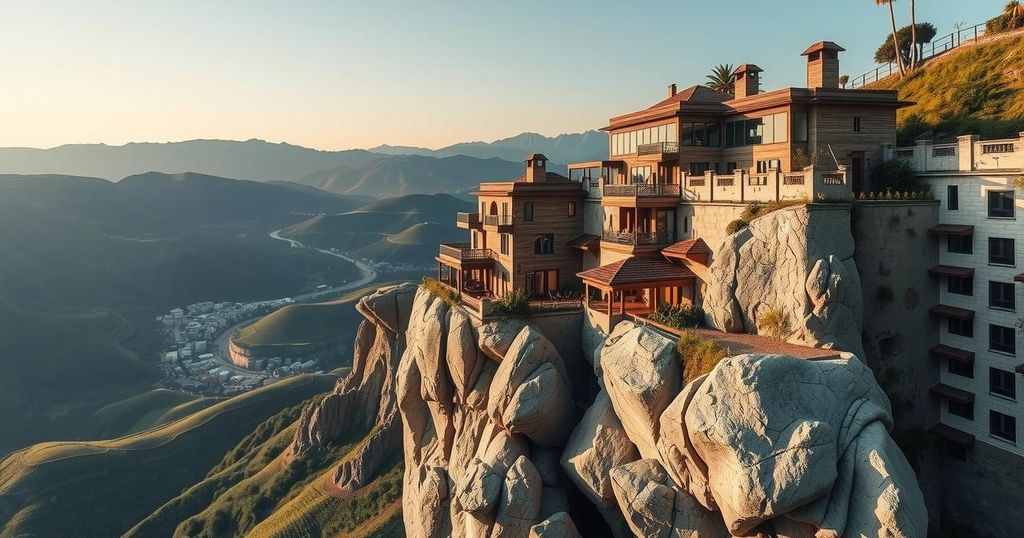Residents in La Paz, Bolivia, particularly in the Valle de las Flores neighborhood, face significant risks living in precarious homes prone to mudslides and flooding. Despite the designation of these areas as dangerous “red zones” by authorities, socioeconomic pressures force many to remain. The lack of safe, affordable housing exacerbated by urban planning failures and climate change poses ongoing threats to these communities.
In the Valle de las Flores neighborhood of La Paz, Bolivia, shopkeeper Cristobal Quispe lives in a new brick home precariously situated on a hillside where a mudslide in 2011 claimed his previous residence. At present, Quispe, 74, exhibits trepidation towards the rainy season from November to March, fearing that rain could trigger catastrophic mudslides. Although local authorities have designated the region as a perilous “red zone,” many residents, including Quispe, feel compelled to remain in the area due to the absence of alternative housing options. A significant portion of these residents are part of the Aymara Indigenous group and have occupied the land all their lives, believing it might gain value in the future.
La Paz, which sits at an elevation exceeding 11,500 feet and is traversed by over 300 rivers, is marked by unstable soil. The municipality has reported that nearly 20% of properties are located in regions categorized as “high” or “very high” risk, predominantly within shantytowns. In the past season, 16 fatalities due to landslides and severe flooding have been documented. Urban planning deficits and insufficient investment in disaster resilience contribute to the dangers residents face, as noted by experts such as Ramiro Rojas from Bolivia’s Univalle University.
Rojas highlights that Latin America’s vulnerabilities, exacerbated by socioeconomic disparities, compel communities to settle in high-risk areas. In the last decade, natural disasters in the region have claimed the lives of at least 13,878 individuals, as per research from the Catholic University of Leuven.
Other voices like Fernando Viviescas from the National University of Colombia emphasize that the current threats from climate-induced disasters were not adequately considered during urban development. With approximately 83% of Latin America’s population now residing in urban areas, the need for safe, affordable housing intensifies.
Cristina Quispe, a local grocery seller, reports that several neighbors have recently lost their homes to mudslides. Although her own house leans dangerously, she expresses a stoic calmness about her situation: “I’m not afraid. I’m calm. Anyway, it’s not like I have somewhere else to go.” Lucas Morales, a mechanic living by the Irpavi river, describes the sudden devastation that floods can bring to his property, lamenting built infrastructure that inadequately addresses flooding risks.
Stephanie Weiss, an environmental engineer at the Bolivian Institute of Urbanism, states that La Paz struggles with a severe shortage of safe, affordable housing. The push for land ownership, while beneficial for future savings, has inadvertently led impoverished communities to remain in precarious locations, with many clinging to the ideal of owning “their own home, even if it is on the edge of a cliff.”
The article addresses the precarious living conditions faced by residents in La Paz, Bolivia, particularly in the Valle de las Flores neighborhood, where individuals are confronted with the risks of mudslides due to unstable geological conditions. The socioeconomic context heavily influences the residents’ decisions to remain in these hazardous areas, as many are part of indigenous groups who have historically inhabited the land. The article outlines the impact of urban planning failures and climate change, which exacerbate the vulnerability of these communities.
In summary, the residents of La Paz grapple with the dual challenges of living in high-risk areas while facing significant social and economic pressures. Despite the threat of natural disasters, such as mudslides and floods, many residents feel they have no viable alternative but to remain in their precarious homes. The ongoing struggle for safe housing in Latin America highlights the need for comprehensive urban planning and increased investment in disaster resilience to protect vulnerable communities.
Original Source: www.barrons.com






